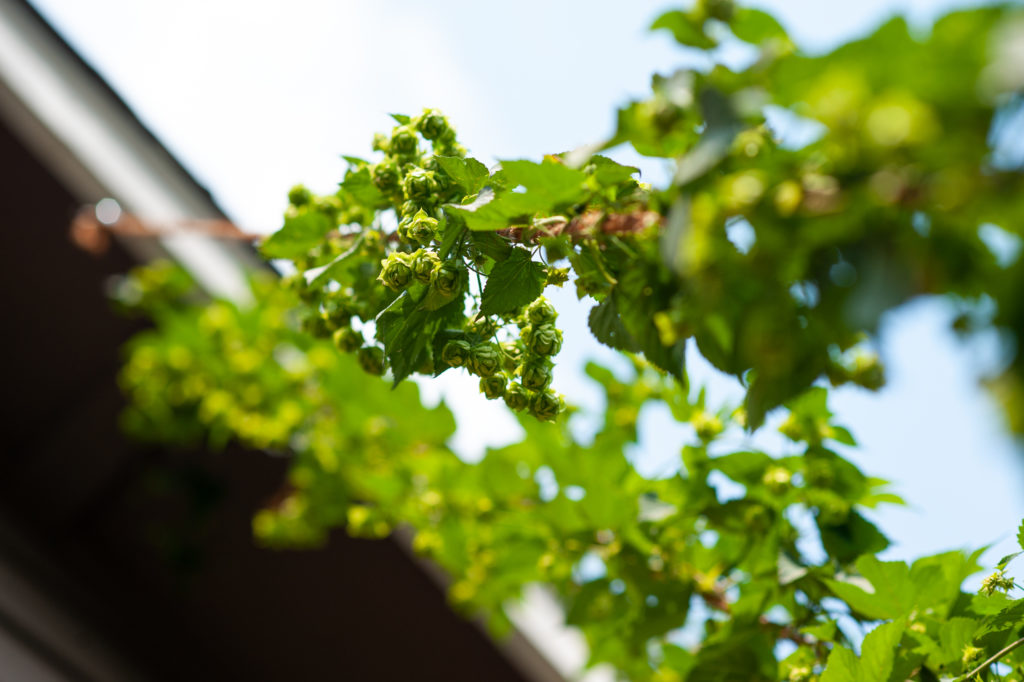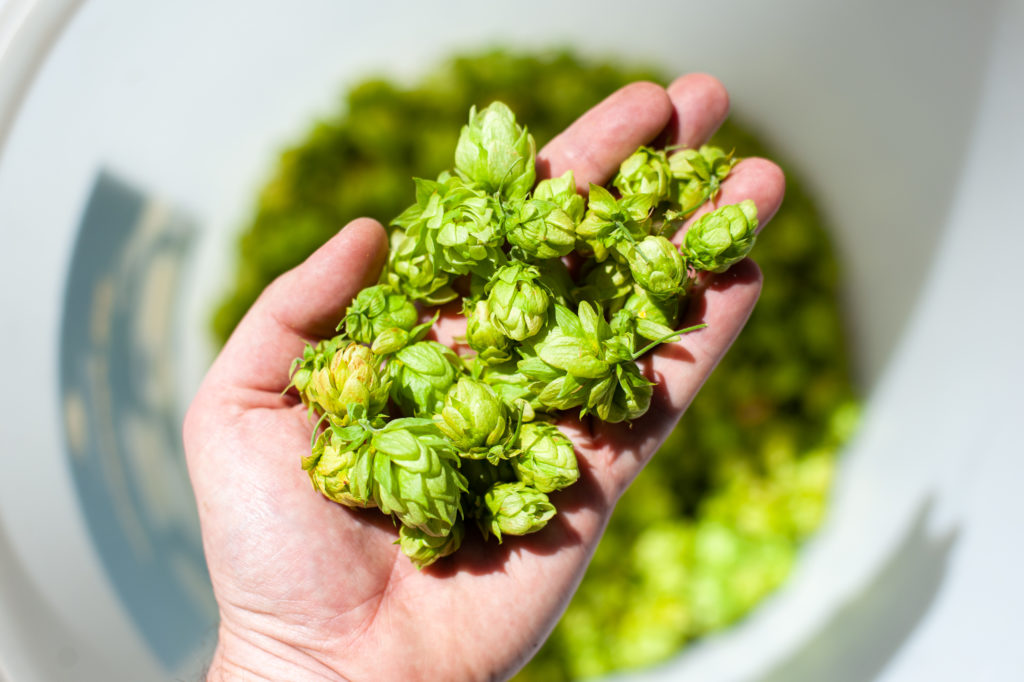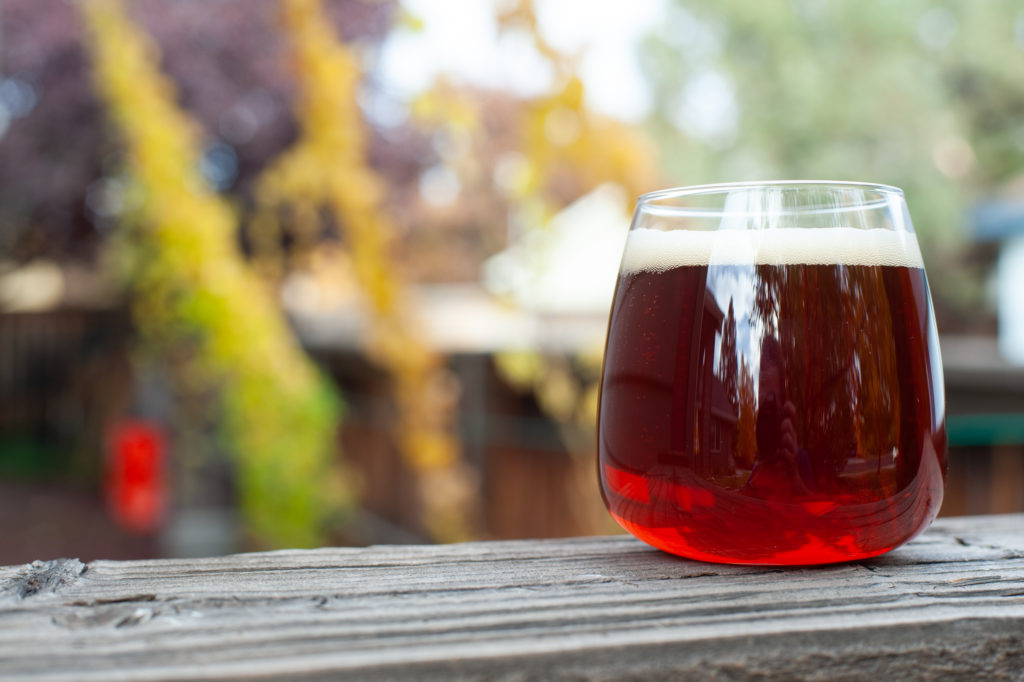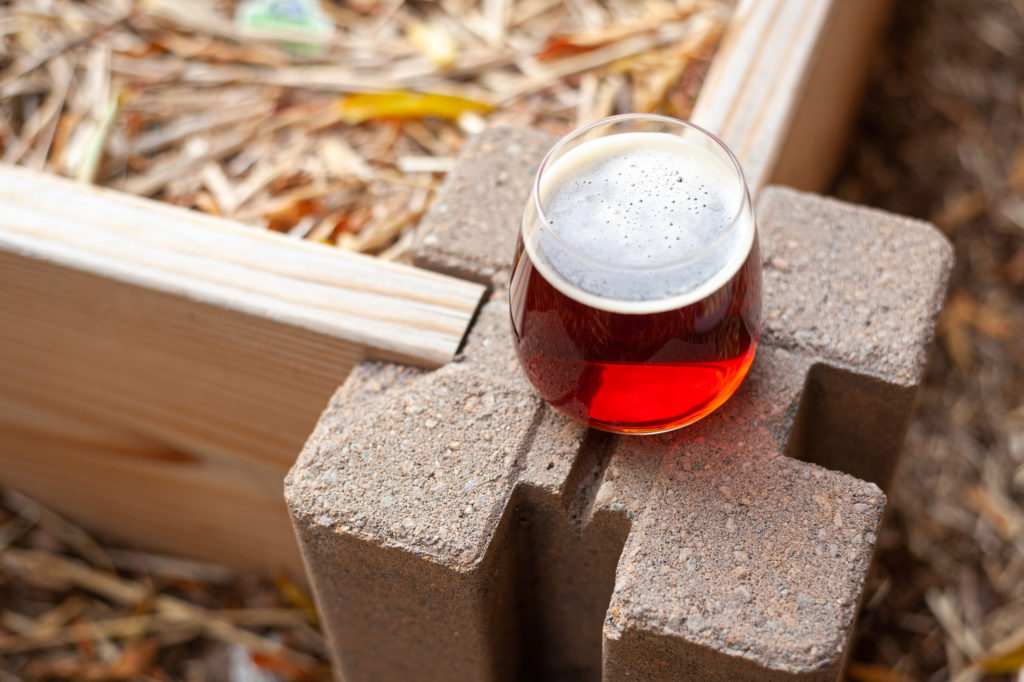Seasonally Appropriate Drinking: Fresh Hop Amber Ale

I’ve been growing my own hops since 2018, and like all my gardening adventures it’s been a lot of fun mixed with a lot of frustration. In that time, I’ve almost never had a harvest worth a crap, and I’ve never made a really good fresh hop beer with my own cones.
My plants have it pretty rough. To begin with, my house faces southwest, which means the best spot for growing hops is in the front yard. But, yeah… that ain’t happening. Not only is that real estate taken up by our garden beds, but there’s not enough vertical room for hop bines to stretch their legs. So instead, they live on the southeast-facing side of the house. On the plus side, they can run up the 20 feet or so to the peak of the roof, but the downside is that the daylight doesn’t last nearly as long as they’d prefer. Perhaps worse, the soil here in Central Oregon is rocky, volcanic stuff that’s all but impossible to dig through without a backhoe. So my hops all live in large containers, which stunts their growth. And then there are the aphids and spider mites, which seem only to thrive all the more when I hit them with neem oil.
But nature, uh… finds a way. And this year, my hops did too, despite an early-summer heatwave, the best efforts of tiny pests, and periodic wildfire smoke. Come September, I had a surprisingly healthy looking crop.
So as the weather started to cool and the days grew shorter this fall, I took stock of my bounty and decided to do something a little different with my fresh hops. Living here in the PNW, I have access to a remarkable bounty of commercial fresh hop beers, but they’re almost universally pale ales, IPAs, or lagers. That makes sense, of course—those styles highlight hops well. But I wondered if I could use them to jazz up an otherwise malt-driven style. Something seasonally appropriate. Something like, say… an amber ale?
What’s in it?
The Vitals
- Name: Bine to Beer
- Category: BJCP 19A
- Method: BIAB, full-volume mash
- Batch size: 4.5 gallons
- Mash: 152F for 60 minutes
- Boil: 60 minutes
- Fermentation: 65F for 2 days, then 68F until finished
- OG: 1.056 (13.8 Bx)
- FG: 1.009 (6.6 Bx)
- ABV: 6.2%
- IBU: 40ish
The Grain
- 6 lbs 2.4 oz Mecca Grade Lamonta (75.5%)
- 13.6 oz Weyermann Munich I (10.4%)
- 8 oz Briess Extra Special (6.1%)
- 4.5 oz Franco-Belges Caramel Munich 40 (3.5%)
- 4.5 oz Mecca Grade Opal 44 (3.5%)
- 1.3 oz Crisp Pale Chocolate (1%)
The Hops
- 11g Warrior [17.7% AA] @ 60 minutes (23.5 IBU)
- 250g Cashmere, Centennial, and Cascade fresh hops @ FO/WP (roughly 15 IBU)
The Rest
- Yeast: US-05 cake from failed brown ale (maybe I’ll tell that story one day)
- Water: 5.5 gallons Bend tap + 3g calcium chloride and 8g gypsum
- Presumed Water Profile: Ca2+ 137 | Cl– 72 | SO42- 215 | Mash pH 5.31
» BeerXML Download «
How’d it go?
Step one? Harvest the hops. My side yard is a bit cramped, so getting a ladder up is a bit of PITA, but eventually I was able to finagle it and get to collecting cones. I quickly found that while all of my plants produced, the Cashmere bines really hit it out of the park compared to the Cascades and Centennials. Go figure. But that’s fine, I like Cashmere.

Next I had to decide how to actually use the hops. Traditionally, fresh hop beers are made with lots of fresh hops added late in the boil or at the whirlpool/hopstand phase. Since their alpha acid level is unknown, this is a good way to make sure you don’t end up with a palate-wrecking IBU bomb. In the case of my amber, I decided to bitter to about 24 IBU with a neutral, high-AA hop (Warrior) and then throw all 250g of fresh hops in at flameout, whirlpooling them for 20 minutes before continuing to chill the wort.
To ballpark the IBU contribution from my fresh hops, I took the commonly suggested 5:1 fresh hop to pellet ratio—meaning you need roughly five times the fresh hops in weight to get the same effect as pellet hops—and plugged in a known value for Cashmere pellets. According to BeerSmith, 50g of Cashmere pellets at FO would get me about 15 IBU, putting the total near 40. Perfect.
Brewing the beer itself was simple. I did my usual single-infusion at 152 degrees, skipped the mash-out, and boiled for an hour. At flame-out, I piled the bucket-full of hop cones into my large but not-that-large hop spider, killed the power, and got to whirlpooling with my big stainless spoon.
Needless to say, the aroma was intense. But would it translate into a hop-driven amber with the grassy, fruity qualities I love in commercial fresh hop beers?
How’s it taste?
No, not really.

Appearance: Deep amber, leaning ruby red, and extremely clear for a beer made with US-05. The head is big, fluffy, and just a bit off-white to start, but quickly reduces to a thin cap that does stick around nicely and leave some fine lacing on the sides of the glass.
Aroma: As you’d expect in an amber, malt leads here. I get biscuity/crackery base malt, a bit of molasses, and a sweet red delicious apple thing. That’s all good, but unfortunately there’s also a slight sharpness to the nose of this beer that I don’t love—one that’s reflected in the taste, though not as assertively. (I’ve never had this issue with pale or dark brews, but it’s cropped up several times in mid-color beers like ambers and brown ales. It definitely bears investigation.) The hops are here too, and they might be playing into that oddly sharp aroma, but they play a clear second fiddle to the malt.
Taste: Sweet malt is balanced by an even, moderately bitter hop backbone. I doubt anyone would ever pick out Cashmere hops here (or either of the other two varieties), but they’re definitely doing their part. The beer comes across as very slightly thin, but also has a distinct sweetness. The acrid edge I got in the aroma is here, too, but it’s more subdued on the tongue—just the slightest hint of something being off. The longer I let it linger, the more I’m wondering whether this has to do with the malt I used (perhaps the pale chocolate) or the fresh hops themselves. Using fresh hops is always a bit of a lottery, after all. On the whole, this isn’t a great showcase for fresh hops, or perhaps mine just don’t have the punch needed to get noticed.
Mouthfeel: This one comes across as relatively thin and dry, as you’d expect from such a high sulfate ratio. Next time I might try for a more balanced water profile to give it a bit more fullness. However, the dryness does make it really easy to drink. Maybe too easy.
Would I brew it again?

I’d try brewing this recipe again with pellet hops or extract, but I don’t think I’d repeat the fresh hop amber experiment—at least not with my homegrown hops. The idea is probably a good one, but the unpredictable qualities of my homegrown harvest dragged it down in this case. It’s fun to grow your own, but if you want to actually get a sense of what they’re doing in your beer, I think it’s probably a good idea to keep it simple.
Maybe there’s a reason fresh hop pale ales are so popular, after all?

Leave a Reply